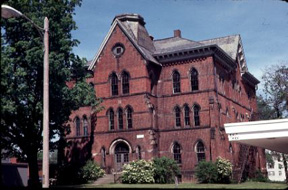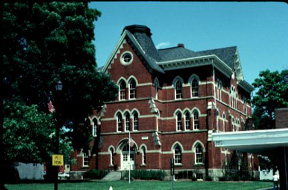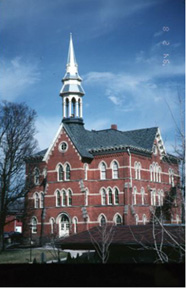
|
1873 |
Groundbreaking occurs. Total construction costs are $37,128.55. |
"Oberlin has too many buildings without any pretense to beauty, and too many which are positively ugly."
(Lorain County News, February 1873)
(The Lorain Constitution, May 20, 1874)
|
1874 |
The building is dedicated. Among those delivering speeches are Oberlin College President James Fairchild, Reverend James Brand, and the Honorable James Monroe. |
"You may well be proud of this house which you have caused to be built. It is an ornament to our village, and will long remain one of its most attractive features. And we are sure no one of you, surveying its chaste and elegant proportions, and hearing the unanimous voice of commendation from strangers who look upon it, will wish that it had one element less of architectural beauty or adornment."
(From the speech by E.J. Goodrich, Chairman of the Building Committee, at the dedication, November 9, 1874)
"The building... is antiquated, inconvenient, unsanitary and in nearly every way wholly unsuited for modern high school work... The one great need, not only of the schools but of the entire community, is a new modern high school building which will be attractive and not repulsive."
(1916 Report from School Superintendent Howard Rawdon)
|
1921 |
The State Industrial Commission inspects the building and threatens to close it if repairs estimated to cost $75,000 are not made. |
"...the use of the building for school purposes must be discontinued."
(State Industrial Commission inspection report, 1921)
"At the request of the school board George Feick, well-known contractor, has made a careful study of the details of the old building... Mr. Feick's opinion is that the required changes [stipulated by the State Industrial Commission] cannot be figured as costing less than $75,000. It is the judgment of the board that so much money should not be spent on the old building."
(Oberlin News, Feb. 16, 1921)
|
1923 |
The last Union School class graduates, and the bell is taken from the tower and moved to the new high school (now Langston Middle School). The Board of Education tries but fails to sell the building and several adjoining lots. It passes briefly among several different owners. |
"No offers meeting the approval of the board of education were received at the auction held for the sale of the old high school site on Saturday, and all bids were rejected... The highest bid received for the site and building as a whole was $12,500."
"For the second time the old high school property was put up for sale at auction on Saturday, and for the second time it failed to sell."
(The Oberlin News, April 19 and May 31, 1923)
|
1927 |
Local merchant Edmund Westervelt purchases the building for $12,500 and transfers ownership to Oberlin College. The college renovates it for "temporary" classroom use. |
Recommendation of the Trustee Committee on Location, Plans, and Construction of College Buildings: "That the Prudential Committee be authorized to take suitable action to place the old High School building on South Main Street in condition for use to five or ten years for such purposes as the College may need."
(Bulletin of Oberlin College, Annual Report of the President, 1926-27)
Report of the Assistant to the President:
"It is fitting to call attention to the timeliness of the gift of Mr. E.C. Westervelt, whose contribution of valuable properties on South Main Street and the building formerly used as a public high school, made possible, by remodeling, the present efficient Westervelt Building, in use by the college as a recitation building. At a very modest cost, the College has admirable facilities which could not have been otherwise provided except for a very much larger expenditure."
(Bulletin of Oberlin College, Annual Report of the President, 1926-27)
"It was thoroughly reconditioned for college uses, and now contains ten recitation rooms, mainly used by the departments of English and modern languages, laboratories for the work in accounting, mechanical drawing, and the phonetic side of Spanish, a study room, and offices for members of the faculty."
(Oberlin College Catalogue, 1927-28)
|
1939 |
The bell is removed from what is now Langston Middle School and put in storage. Its present whereabouts are unknown; there is speculation it was melted down for reuse during World War II. |
|
1940 |
The bell tower is dismantled due to its poor condition. |
|
1961 |
Oberlin College stops using Westervelt Hall for classroom space, following completion of the new King Building. |
|
1963 |
The National Association of College Stores begins using the building as a book storage warehouse. |
|
1973 |
Various plans for the building's reuse or demolition are proposed. The building is listed on the National Register of Historic Places in 1974. |
"The 100-year old structure was one of the prime targets of the Space Utilization Study conducted by Dober Associates, who suggested... that one of the only ways to preserve the historically significant but superfluous edifice was to donate it to the city. One of the key points in today's Trustee discussion will be the strings attached to any possible offer, constraining the City to use Westervelt for that purpose, rather than selling it to concerns interested in converting it into a parking lot."
(The Oberlin College Review, April 6, 1973)

"Westervelt has been donated by Oberlin College to the municipality, but OC has retained title pending formulation by City Council of plans to use the building."
(Oberlin News-Tribune, May 23, 1974)
|
1976 |
Oberlin College deeds the building to the City of Oberlin. |
|
1979 |
A.H. "Kenny" Clark purchases the building for $32,500 and undertakes an exterior renovation. |
"In late 1979 after lengthy negotiations A.H. Clark purchased the property... from the city. Restrictions in the sale... included that exterior restoration be finished within three years after recording of the deed. Mr. Clark has gone considerably beyond the provisions of the agreement in order to make the property available as headquarters for the Sesquicentennial Committee. Besides extensive cleaning inside and outside... the 127 windows have had over 1,000 panes of glass replaced."
(Martha Lermond, Westervelt Hall: Its First Century, December 12, 1982)

|
1983 |
Westervelt Hall serves as headquarters for Oberlin's Sesquicentennial Committee. |
|
1992 |
The building houses the Oberlin Co-op while its current facility is being prepared for use. |
|
1995 |
The Nord Family Foundation purchases the building from Kenny and Ada Clark. An endowment fund within the Community Foundation of Greater Lorain Count is established to help provide for its maintenance and operation. Construction begins in August to adapt the structure for renewed use. |
|
1996 |
Occupancy and opening of the New Union Center for the Arts. |
|
Update! March 1997 |
The bell tower is restored to the New Union Center for the Arts. |
